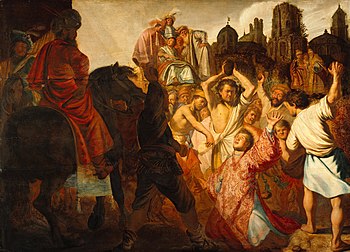art.wikisort.org - Painting
The Stoning of Saint Stephen is the first signed painting by Dutch artist Rembrandt, made in 1625 at the age of 19.[1] one of his earlier works is an oil painting on a wood panel and currently exhibited at the Musée des Beaux-Arts de Lyon.
![This figure, nestled between Saint Stephen and the man holding a large rock over his head, is the first extant self-portrait of Rembrandt.[2]](http://upload.wikimedia.org/wikipedia/commons/thumb/2/2e/Rembrandt%27s_Stoning_of_Saint_Stephen_%28detail%29.jpg/220px-Rembrandt%27s_Stoning_of_Saint_Stephen_%28detail%29.jpg)
| The Stoning of Saint Stephen | |
|---|---|
 | |
| Artist | Rembrandt |
| Year | 1625 |
| Medium | Oil on oak panel |
| Dimensions | 89 cm × 123 cm (35 in × 48 in) |
| Location | Musée des Beaux-Arts de Lyon, Lyon |
This work is inspired by the martyrdom of Saint Stephen which is recounted in Acts 7. This young deacon in the Christian community of Jerusalem was sentenced to death by stoning. The painting was influenced by the art of Caravaggio and Adam Elsheimer.[3] It represents the moment when Stephen was stoned outside the city by his many tormentors (about twenty characters), and he utters his last words to Christ as the light around him shows that the heavens are open.[4]
The painting is divided into two distinct zones with a diagonal creating an effect of chiaroscuro: on the left, a man on horseback is in the shadow, and on the right, Stephen and his persecutors are in the light. Saul of Tarsus can be seen seated in the background holding in his lap the coats of the stoners. Some inaccuracies in the drawing can be seen.[4] The character behind Stephen seems to be a self-portrait done into a wider composition, as Spanish painter Diego Velázquez did in Las Meninas.[5] John Durham suggests that Rembrandt "presents himself as a somewhat alarmed presence, a participant who may be having second thoughts about what was taking place."[6]
It is argued that the painting shows as many as seven different variations of Rembrandt's self-portrait.
Rembrandt Etching of Saint Stephen
- Later stage etching by Rembrandt in the National Gallery of Art.
References
- Starcky, Emmanuel (1990). Rembrandt. Hazan. p. 45. ISBN 2-85025-212-3.
- Wallace, Robert (1968). The World of Rembrandt: 1606-1669. New York: Time-Life Books. p. 38.
- Françoise Caillet-Mangin (28 March 2006). "Rembrandt ou la lumière réinventée" (in French). Convivialité en Flandre. Retrieved 19 March 2010.
- "Harmensz van Rijn Rembrandt (Leyde, 1606 - Amsterdam, 1669), La Lapidation de Saint Etienne" (in French). Musée des Beaux-Arts de Lyon. Archived from the original on 22 July 2011. Retrieved 19 March 2010.
- Karel Vereycken (13 December 2006). "Rembrandt : 400 ans et toujours jeune !" (in French). Solidarité et Progrès. Retrieved 19 March 2010.
- Durham, John I. (2004). Biblical Rembrandt: Human Painter In A Landscape Of Faith. Macon: Mercer University Press. p. 60. ISBN 0865548862.
External links
На других языках
[de] Die Steinigung des heiligen Stephanus
Die Steinigung des heiligen Stephanus ist ein Ölgemälde des niederländischen Malers Rembrandt van Rijn. Es ist als Querformat auf Eichenholz ausgeführt und wurde als eines der frühesten Werke des jungen Rembrandt um 1625 gemalt. Über dem Haupt des Stephanus hat Rembrandt sein eigenes Gesicht und rechts neben dessen erhobener Hand das Gesicht seines Freundes und Kollegen Jan Lievens dargestellt. Damit ist das Gemälde auch das früheste unter Rembrandts mehr als 75 Selbstporträts. Das Werk wurde erst 1962 durch Horst Gerson im Magazin des Musée des Beaux-Arts in Lyon entdeckt, über seine Geschichte vor dem Erwerb im Jahr 1844 ist nichts bekannt.- [en] The Stoning of Saint Stephen
[fr] La Lapidation de saint Étienne (Rembrandt)
La Lapidation de saint Étienne est un tableau peint par Rembrandt en 1625. Il a été acquis par le musée des Beaux-Arts de Lyon en 1844 et restauré en 1965[1]. C'est le premier tableau connu de Rembrandt[2] dans lequel il s'est d'ailleurs représenté. La scène biblique représentée est un topos de l'art chrétien, déjà traité par Paolo Uccelo, Annibale Carraci, et Adam Elsheimer entre autres.[ru] Избиение святого Стефана (Рембрандт)
«Избиение святого Стефана» — это картина, написанная Рембрандтом в 1625 году. Она была приобретена Музеем изобразительных искусств из Лиона в 1844 году и восстановлена в 1965 году. Эта работа вдохновлена мученической смертью святого Стефана, о которой говорится в книге Деяния Апостолов. Этот молодой дьякон в христианской общине Иерусалима был приговорён к смерти побиванием камнями собранием синедриона, великого совета духовных лидеров еврейской общины. На картину повлияло искусство Караваджо и Адама Эльсхаймера.[1]Другой контент может иметь иную лицензию. Перед использованием материалов сайта WikiSort.org внимательно изучите правила лицензирования конкретных элементов наполнения сайта.
WikiSort.org - проект по пересортировке и дополнению контента Википедии
